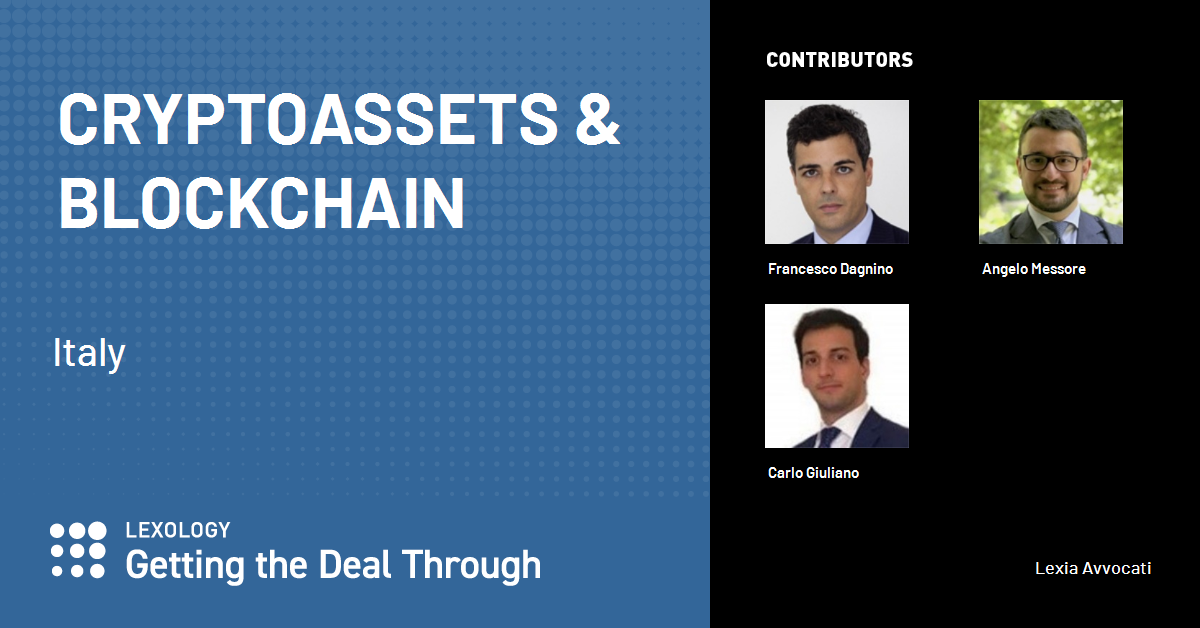– written by Francesco Dagnino, Angelo Messore and Carlo Giuliano
Lexia Avvocati wrote an updated reference guide for Lexology about the legal and regulatory framework of cryptoassets in Italy.
Despite still operating in an uncertain environment, some changes have been made this year. The new registering system for VASPs has finally been introduced, and now we can rely on a registering system that helps organize the activity. Moreover, we expect the MiCA Regulation to be approved soon by EU institutions after some steps forwards happened during the summer of 2022. Finally, some new introductions have been made by the Italian Supreme Court as regards the classification of Bitcoins and the legal definition of DAOs.
The aim of the guide is to give a legal overview and future perspectives for everyone operating in the cryptocurrencies and blockchain field.
Read the full guide on Lexology.com
Legal Framework on cryptoassets
VASPs have to be compliant with Italian AML rules, based on the virtual currency definition: “a digital representation of value that is not issued or guaranteed by a central bank or a public authority, is not necessarily attached to a legally established currency but is accepted as a means of exchange for the purchase of goods and services or investment purposes, and that can be transferred, stored and traded electronically”.
In the guide, we report a series of characteristics that identify those virtual currencies and custodian wallet providers that are subject to the Italian AML regime.
VASP Register
On 17 February 2022, the VASP Decree has been published in the Italian Official Gazette. The VASP Decree determines that only VASPs that are enrolled in the VASP Register are allowed to operate in Italy. This has been an important decision that pushes virtual currency operators towards a more clear and regulated activity, defining a significant step forward for the field in Italy.
In the guide, we define everything that concerns this new VASP registry, which is kept by the OAM:
- Who needs to be registered
- How to submit the registration,
- which documents are required,
- how long will the process take to be processed,
- what are the obligations for VASPs after being listed in the register?
Moreover, besides the rules on VASPs, depending on their nature and regulatory classification the provision of services concerning cryptoassets could also be subject to other rules, such as Italian rules on financial products, financial instruments, and e-money, payment instruments, or payment services. Details are deepened in the guide.
MiCA Regulation: an incoming framework for ‘cryptoasset services providers’ in the EU
We expect further changes during the beginning of 2023 regarding the Italian legal framework on cryptoassets. All will depend on the approval of the MiCA Regulation by EU institutions (first published by the European Commission in September 2020). A step forward has been made during the summer of 2022, after months of discussions, when a temporary agreement has been reached by the Presidency of the Council of the European Union and European Parliament.
Another relevant introduction was Regulation 2022/858, published on June 2, 2022, on a pilot regime for market infrastructures based on distributed ledger technology (the DLT Pilot Regime). It will enter into force on 23 March 2023 and will introduce specific rules to trade transferable securities (eg, shares, bonds, etc.) that are issued, recorded, transferred, and stored on a distributed ledger technology.
Government policy
In the guide we sum up everything that has been recently decided by the government, such as the CONSOB public consultation in 2019, the VASP Decree mentioned before, and the upcoming MiCA regulation. All that shows a growing interest in the topic and a perceived need to monitor the market more closely.
Regulatory authorities and penalties
Stated the fact that no government authority is specifically dedicated to the regulation and supervision of cryptoassets, in the guide we list the roles and tasks of all subjects involved, such as the OAM, CONSOB, and Bank of Italy. Penalties vary and depend on the misconduct. In the guide, we analyze different situations, from failing to manage data correctly to a lack of clarity regarding suspicious transactions.
Industry associations
In the guide, we mention the leading industry associations addressing legal and policy issues relating to cryptoassets.
Cryptoassets for investment and financing
Regulatory threshold and investor classification
In the guide, we define the nature and features of crypto assets to identify the application or non-application of the regulation under Italian laws.
We define:
- Cryptocurrencies viewed as tokens in a broader sense
- Virtual currency (such as pure cryptocurrencies like Bitcoin, Ether, etc)
- Investment or security tokens
- Tokens that do not qualify as financial instruments
- Stablecoins
- Utility Tokens
- NFTs
Despite there being no specific classification applying to investors in cryptoassets, in the guide we identify entities considered to be professional and retail clients.
Rules and restrictions for financial instruments
We define rules and on:
- Initial coin offerings
- Security token offerings
- Stablecoins
- Airdrops
We report laws and regulations on the following activities:
- Advertising and marketing
- Trading restrictions
- Crowdfunding activities
- Transfer agents and share registrars
- Anti-money laundering and know-your-customer compliance
Cryptoasset trading
In the guide we give an updated overview of cryptoasset trading guidelines as regards:
- Exchange of fiat currency and cryptoassets
- Exchanges and secondary markets: alternative trading systems and secondary markets
- Cryptoasset custodians; broker-dealers; decentralised, peer-to-peer and foreign exchanges;
- Taxation
Cryptoassets used for payments
Even though the cryptoasset is not yet identified ad as a lawful form of payment, the European Central Bank is working on the introduction of a digital Euro as a form of central bank digital currency (CBDC). Moreover, Italian banks and financial institutions are considering whether to offer cryptocurrency accounts to their clients.
Cryptocurrency mining & distributed ledger technologies
In the guide, we mention the Italian regulation on cryptocurrency mining licenses, if any, and possible guidelines by tax authorities. Moreover, we report eventual licensing and restrictions for blockchain/DLT nodes and possible legal liabilities for DAO (decentralized autonomous organization).
Finally, we assess the legality of smart contracts for the Italian system and the possibility to patent blockchain/DLT technologies.
Update and trends
We report the new decisions the Italian Supreme Court has recently issued concerning the qualification of Bitcoins as a financial product, as well as a new analysis on the legal definition of DAOs (paving the way for future interventions by policymakers in developing new solutions).
Visit the Lexology website to read the full document.
About Lexology
Lexology is one of the most trusted sources of information on international legal updates, analyses, and insights. It publishes over 500 articles every day from 900+ leading law firms and service providers worldwide. Lexia contributes to the project with Italian legal insights on several practice areas.



